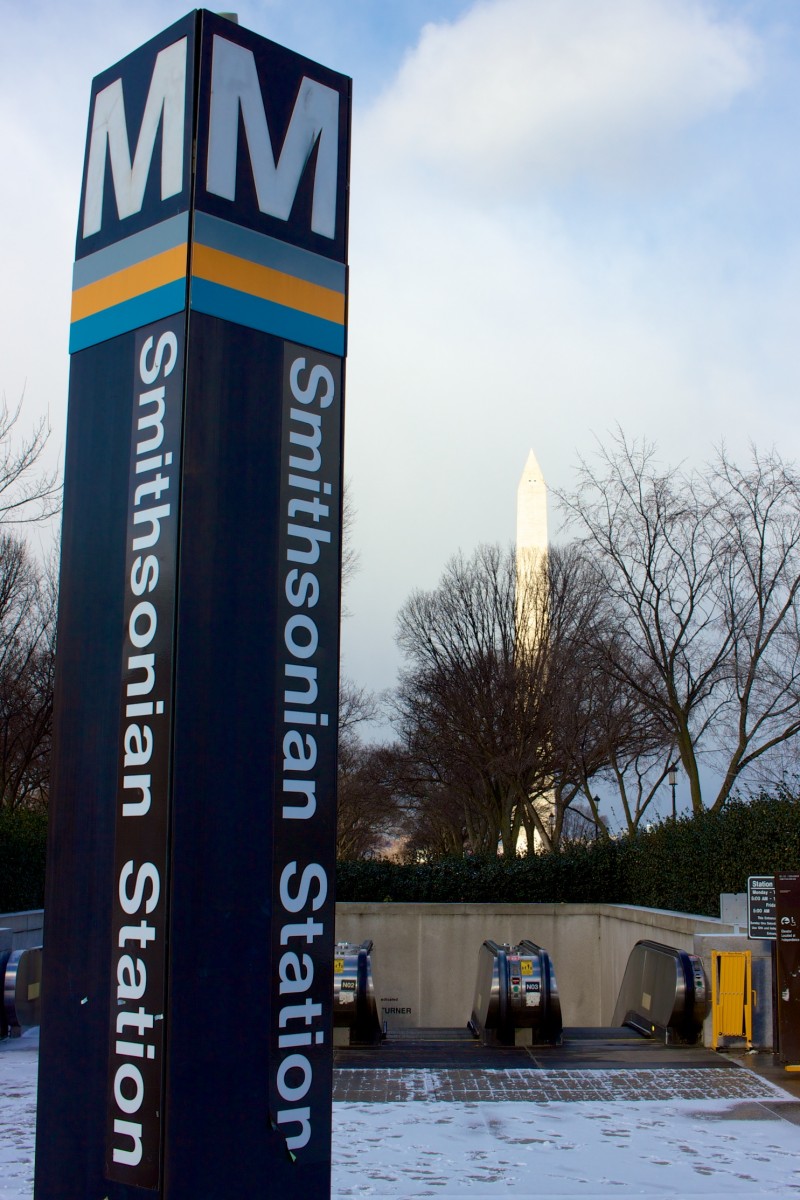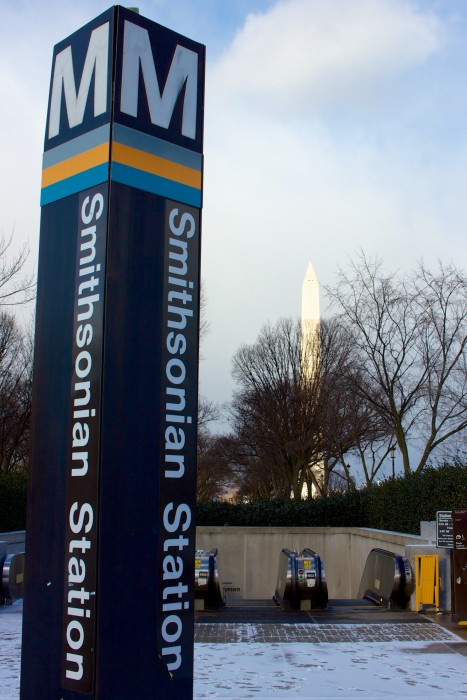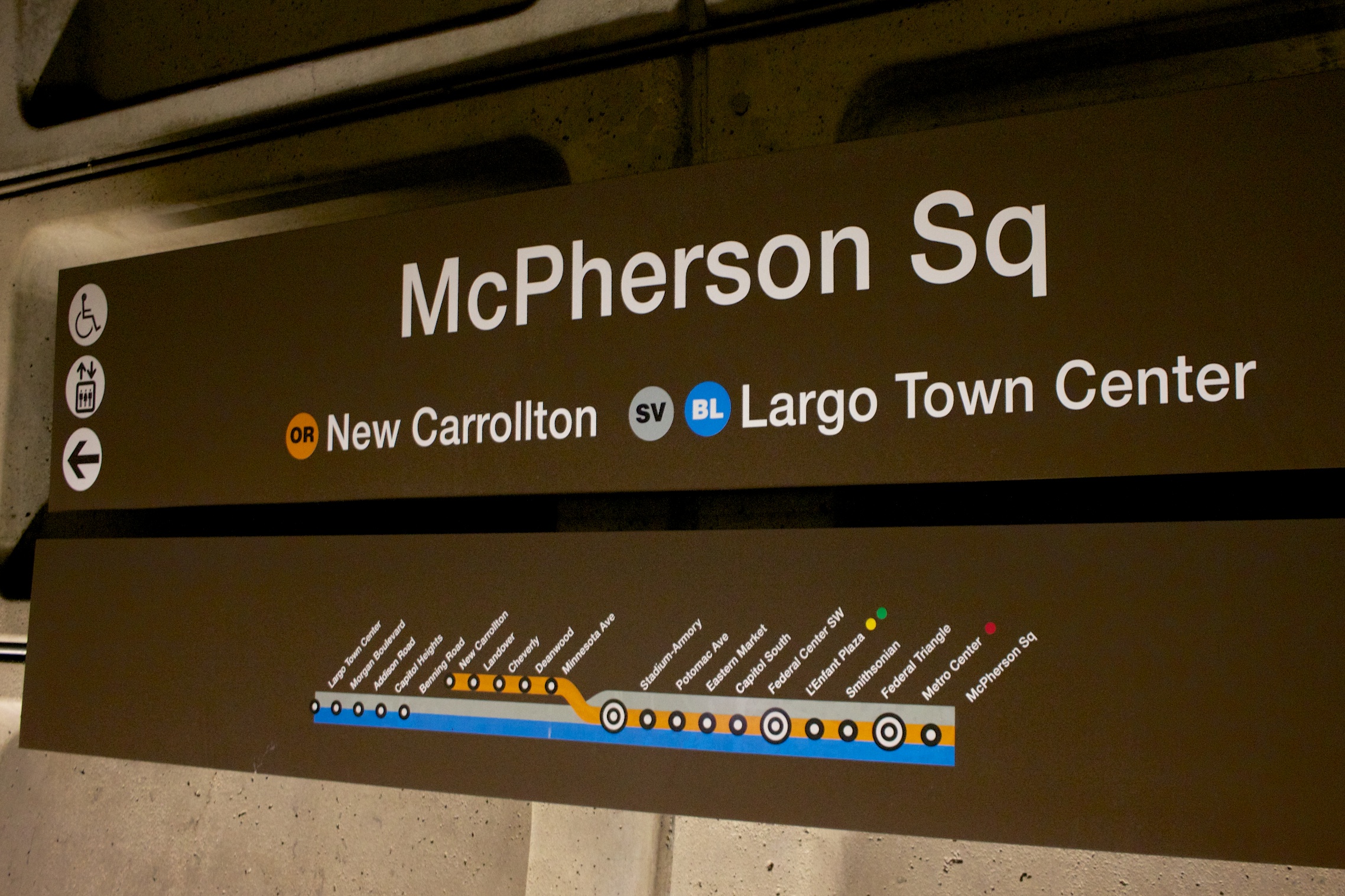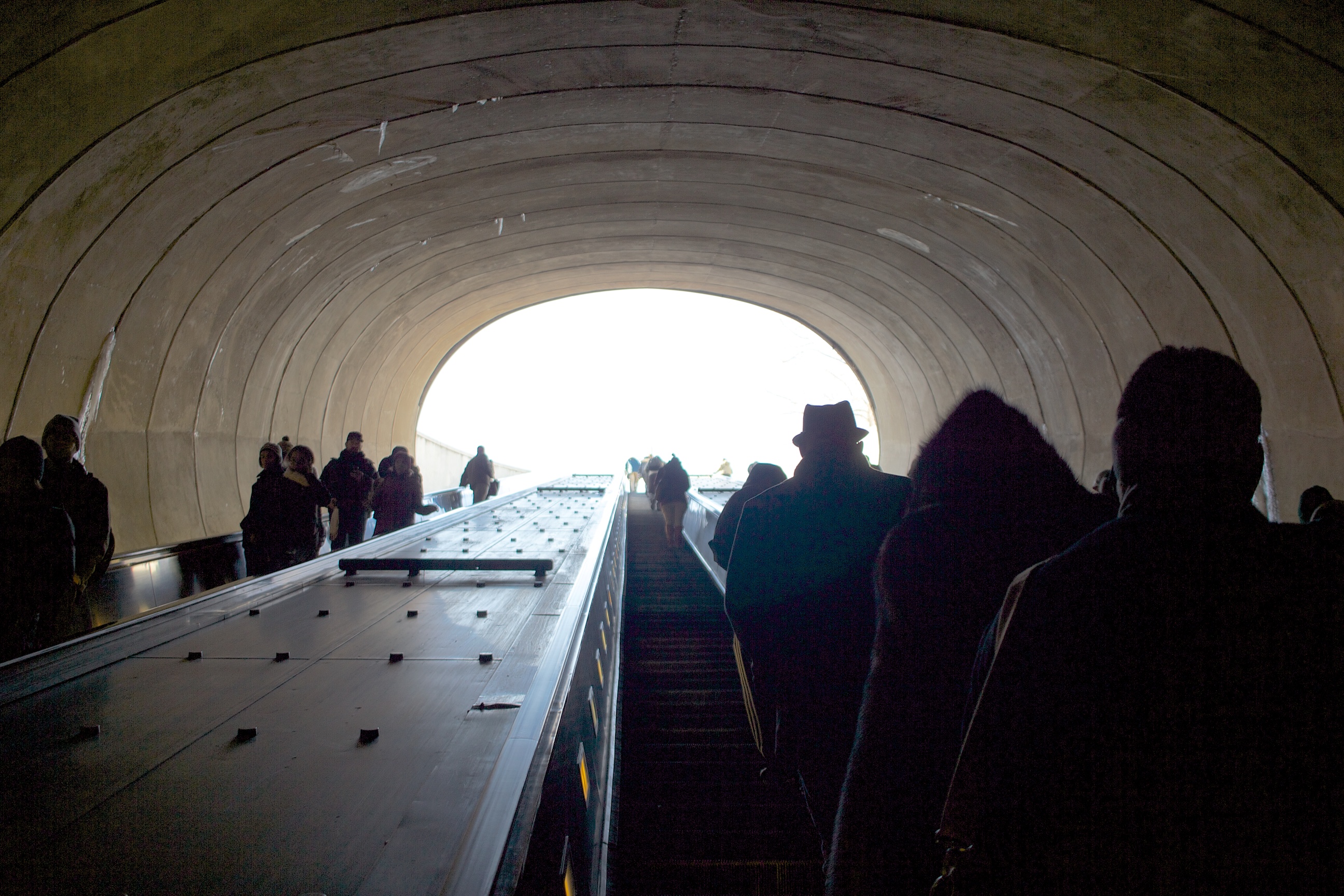
Washington, D.C. – How to Use the Metro (Subway)
 As a major U.S. city, Washington can be a little overwhelming to new visitors. One of the ways to make it more manageable, though, is by utilizing the D.C. subway system–called the Metro. Using the Metro, however, can itself be intimidating, especially to visitors who do not have a mass public transportation option in their hometown. Fear not intrepid readers, the Metro is fairly easy to understand and, after reading this guide, you will surely be riding like a local.
As a major U.S. city, Washington can be a little overwhelming to new visitors. One of the ways to make it more manageable, though, is by utilizing the D.C. subway system–called the Metro. Using the Metro, however, can itself be intimidating, especially to visitors who do not have a mass public transportation option in their hometown. Fear not intrepid readers, the Metro is fairly easy to understand and, after reading this guide, you will surely be riding like a local.
What Is the Metro
Okay, technically the Metro system is all bus and rail under the authority of WMATA (Washington Metropolitan Area Transit Authority), but whenever someone says “the Metro,” they mean the subway. Of course, the Metro isn’t always underground either. Once it gets out of the urban areas, it often pops its head out and begins to scamper above ground.
Metro gets a lot of grief from locals, and as a former local I certainly shared in that grief quite often. The system has frequent delays, occasional mechanical issues, and seemingly constant escalator and elevator outages. On top of that, the weekend track work and station entrance closures can make a well-designed plan meaningless. Even with all that, now that I am no longer a Metro-commuting local I can step back and compare it with other cities subway systems more easily.
The result: It’s not bad. In fact, it’s pretty darn good. Yes, all of the problems listed in the above paragraph are real, forever annoying, and–if you have to ride it every day–maddening. Luckily, as tourists to Washington, we do not have to deal with the Metro’s flaws every day so can take it for what it is, a very efficient way to move about a very congested city. I’m not alone in this either, Smart Asset recently did a statistical analysis of major U.S. cities’ public transportation and concluded that D.C.’s was the best. (Much to the derision of locals, by the way.)

Where the Metro Covers
I would love to say “EVERYWHERE” except that isn’t true. Looking at the Metro map does make it look like its tendrils stretch into every conceivable neighborhood in D.C., Northern Virginia, and nearby Maryland counties, but on closer inspection there are massive gaps.
Want to visit Georgetown University? Well, its landmark Healy Hall is a solid mile-and-a-half away from the nearest Metro stop. What about the Lincoln Memorial or Jefferson Memorial; surely these super-popular tourist sites are close to the subway! Nope. Each is just shy of a mile from the nearest Metro. There are, of course, other means of getting there including the affordable buses and services such as Uber and Lyft, but that is a discussion for another time.
The point is: don’t assume the Metro goes where you want it to. It is an invaluable means of getting around for tourists, but get familiar with the map and it will save you a surprise later.
Getting Into the Right Station
It doesn’t sound that hard to simply find a station, but if you’ve ever used any subway system you know that the locations can be a little misleading. Washington’s Metro is no different. Here are the three ways in which Metro entrances can be cofusing
Multiple Entrances
Some stations have multiple entrances. For example, let’s look at Metro Center, one of the most popular stations. It is right downtown and acts as a transfer point between the Red, Orange, Blue, and Silver lines. It has 4 entrances.
Metro Center’s official address is 607 13th St NW, and there is an entrance near there (on the corner with G St). On Google Maps, it shows Metro Center on the corner of 12th and G, the site of another entrance. There are also entrances on 11th and G and 12th and F Streets. While they all lead to the same station, you can save yourself a few extra blocks by knowing the entrances. The WMATA stations list helpfully tells you all of the entrances to every station.
Stations in Close Proximity
The north side of the Mall has the most Metro stations, and there are some areas where there can be two or more stations all within close proximity. The best example is on Farragut Square, where there are two stations: Farragut West and Farragut North. Farragut West is on the southwest corner of the square (with another entrance one block west) and services the Orange, Blue, and Silver lines. Farragut West is one short block north and services the Red line. Make sure you know the exact name of the station you want and what line you’re looking for. In cases like this, the Metro post can help. Not only do they have the white M and station name, but also bands of color under the M to represent the lines found in the station.
The Hidden Stations
While the Metro does a good job of marking their entrances with the ever-present brown post, the actual entrances are sometimes hard to see. Often they are just a gap in a building with escalators inside.
Of course, every so often there is a station that is almost completely hidden. The useful Federal Triangle station is like this. It is a Orange, Blue, and Silver station only one block north of both the Museum of American History and Museum of Natural History. While there is a post on 12th St, the actual entrance is in a breezeway in the U.S. Postal Service building. If you walk into the courtyard, the entrance is even harder to find, as shown below.
.
Buying Metro Cards
Now that we’re finally in the station, we have to get on the train. To do that you will need a SmarTrip card, the plastic, rechargeable fare card required to ride the Metro (paper cards were phased out just this week). I am personally a fan of the way Metro uses their SmarTrip cards. For one, they can be purchased online and sent to you (a $2 service fee applies to new purchases) and the value can also be refilled online. For frequent visitors, you can even set up automatic reloads (minimum $20 reload) via the WMATA website.
If you don’t get one sent to you, they can still easily be purchased or reloaded at any station. Usually near the bottom of the escalators are a bank of machines like what’s pictured below. For a new card, you will need to use a smaller kiosk (middle photo below) and pay a $5 new card fee. Once you have your card, it can be recharged easily at the blue-faced machines (far right photo) by following the orange-circled 1, 2, 3. Attendants are usually nearby although most will do no more than point you to the correct machine.
Once you have your SmarTrip card ready to roll, you simply touch it to the blue circle on top of the turnstile (pictured below, not really a turnstile) and the gate will open. A display on top will also tell you the amount of money on your card. You will also need your card to exit a station, where the display will also tell you how much the fare was (it varied depending on time of day and length of trip).
.
Finding the Right Train
First, a very important point when riding the Metro: Know the final station in the direction you are traveling. For instance, if you are on the Red line going from the National Zoo (Woodley Park-Zoo Station) to the Metro Center Station, the train will not say a direction. What will be listed on the train is its final destination, which, in this case, will usually be Glenmont. To throw a wrench in that, during rush hours the Red line is often shortened, so some of the trains may say Silver Spring.
Don’t worry, it’s not as hard as it sounds, just look at a Metro map (they’re everywhere and you can get a brochure with one at any station). First, find the station you’re at, trace your finger to the one you are going to, then keep tracing until you get to the end of the line. That’s the station name to look for on the signs. Once you get to the platform there will be additional signs listing the stations so you can double-check.
Now, there are a few different ways that Metro stations are set up. The simplest is a station that services a single line with a platform in the middle. Everyone goes to the same place and trains arrive on both sides. Then there are the stations that service a single line, but with platforms on opposite sides and the tracks in the middle. The most complex are the transfer stations, where multiple lines are serviced. These require multiple floors and escalators.
Before you get worried, one of the things Metro does fairly well is signs. If it is a shared, central platform, signs like the center photo below tell you all the stops for each side. For other configurations there will be signs like the left photo, with arrows pointing the way.
Also found on the platform is a handy, if often frustrating wait time board. It tells you the color of the train coming, it’s final station, and how long until it arrives. When the train approaches there will often be a bit of a rush. Don’t worry, it’s usually pretty orderly. Stand to the side of one of the doors until (most of) the people exit, then step in and find a seat if you can. Be warned that some of the seats will be facing backwards if you’re prone to motion sickness. The stations will be announced, but in true subway fashion, the announcements are often hard to hear. Keep track of your progress by checking the signs at each station you stop at.
.
Using the Correct Exit
As mentioned above, most stations have multiple exits. Walking out of the correct one can keep you from getting turned around and save some time walking out in whatever weather happens to be outside. There are signs such as the one below to guide you, although they usually only have street names on them, so a rough idea of your destination is necessary. Even if they do have something like “The White House” on them like this one does, know that the exit is actually at Vermont Ave and I St NW, a full 2 blocks from the North side of the White House. If you were using this station to arrive for a White House tour, you would be about 1/2 mile away.
.
Other Notes and Need-to-Knows
That covers most of it, but there are still a few little things that didn’t fit anywhere above. For instance:
Safety
Like all major cities, Washington, D.C. has issues with public safety now and again. If you are in the major tourist areas during normal tourist hours you are very unlikely to have any trouble. Late at night or in lesser-trodden areas you may find yourself either alone or surrounded by people out for a party. No matter the situation, stay vigilant. There is security in Metro stations, but it is not highly visible.
Some Escalators Are Very Long
Like, really long. The Wheaton Station on the Red line boasts a 230-foot long escalator that brings you 115 feet vertically. It is the longest escalator in the Western Hemisphere. In addition, there are 7 other stations with escalators exceeding 160 feet in length (most along the Red line). Beware if you have vertigo.
Stand to the Right
Speaking of escalators, there is nothing–nothing–that will enrage regular Metro users like people standing in the way on an escalator. No matter how tall or how small the escalator is, many people prefer to walk up or down. The rule is simple: walk on the left, stand on the right. Do. Not. Violate!
That covers everything I can think of. Any other tips or questions? Feel free to let me know in the comments below.























Hello, always i used to check website posts here early in the dawn, for the reason that i enjoy to find out more and more.|
Sorry if this was already covered but:
1) Unlike the NY subway system, in DC you will need your card to EXIT the station too – keep it handy. So annoying when tourists get up to the exit turnstiles and stand there digging around for their ticket.
2) The subways don’t run 24/7 like in NY – be aware of their closing time so you don’t get stuck if you are out late partying in Adams Morgan! 😉
And stuff like this happens sometimes: http://www.nbcwashington.com/news/local/metro-shutdown–372144902.html
I will also reemphasize the stand on the right, walk on the left. There is nothing more important to know. And since everyone does this for the Metro, it is done pretty much on every other escalator in DC as well.
Coming in a VERY close second is to NOT stop and stand at the top or bottom of the escalators. It infuriates locals and is dangerous. Just keep moving until you are out of the way of the flow.
Crime is a problem on the Metro, and getting worse, IMO. You need to be very aware of your surroundings at all times. Especially keep your phone and electronic devices in you bag/pockets. A big problem is people using their phones or ipads while riding and someone snatches it out of their hands and bolts off the train.
I always kept my purse or bags on my lap on in front of me if standing.
Trains also tend to be most crowded in the center cars. it can be useful to go to either platform end. the front and the back cars tend to be less crowded (although during rush hour it may not matter much). You can tell just by looking at where crowds are congregated on the platforms.
We visited DC a few years ago and stayed in Alexandria, VA at a Hilton on King Street. The metro was right across the street. The best thing was we never had to deal with the DC traffic. Just ride the Metro into the city and back. King Street was reallly nice with many restaurants in walking distance. It was great!
Another piece of info from a local to all tourists: There are NO public restrooms in any Metro stations or on the trains. No restrooms at all! If you are traveling with kids, be sure to make a restroom stop before entering the station.
There are bathrooms. But actually finding them is hard. And getting any metro worker/booth employee to let you into one requires an act of God.
Nice overview. I suggest that when traveling with multiple adults, tap the fare cards to enter and exit the gates in this order: adult / all children / adult. This way, if there is a problem with his/her card (each person needs their own), a child won’t be temporarily left alone on one side after the rest of your party has passed through. This caught us by surprise when a card glitched during a busy time and it was extremely nerve-wracking.
Another minor note: the Smithsonian stop has two exits. One lets out directly on the mall, and the other lets you out at the Dept of Agriculture (but closer to the Holocaust Museum).
Also, I second everyone’s suggestion to avoid rush hour.
In terms of safety, watch your phone! That’s a common thing for thieves to quickly grab and hop off at the next stop with.
Finally, if space is at a premium, don’t put your purse or bag on the seat next to you. And be polite about giving seats to those who obviously really need them.
This is getting into the weeds a bit, but if you are going to the Zoo, don’t get off at the Zoo stop. Go to the next stop, Cleveland Park.
It is the same distance, but the walk is flat to slightly downhill, whereas the walk from the Zoo stop is uphill. And in the summer in DC, the walk from the Zoo stop can be brutal.
And when you leave, walk down to the Woodley Park-Zoo stop. You also don’t want to walk back up to CP, especially after a long zoo walking the zoo (which is also quite hilly).
A couple of notes:
If you are staying in VA or MD and parking at the station to take the train in, you have to buy the permanent card. You can’t pay cash for parking.
Service is cheaper outside of rush times. Try to avoid these times if you want to save money.
The Metro is expensive compared to most cities. If you have a few people Uber is probably cheaper around the city.
I was going to mention that you cannot pay cash for parking. This is the result of the great management of WMATA. They found 7 million missing from the parking coffers a few years ago…after they had lost millions in previous years the same way. When it first happened, you could only use metro cards to pay. Too bad tourists if you didn’t want to actually buy one! Finally added cc machines.
Also, if the station you plan on using is one of the far out ones (MD,VA), ESPECIALLY if it is end-of-line station (e.g., Shady Grove), you had better plan on being parked by 7am. Here is an article that gives a good idea about bad parking stations and number of parking spaces.
There is a fudge on this, if you want to go later. The carpool spaces (permit only) become open to all at 10am. Although a lot of drivers take advantage and start parking before that 10am.
This is not metro-specific, but related. We took our two kids to DC and wanted a good central location. We stayed at the Holiday Inn by the Air and Space Museum. It was absolutely wonderful — we could get to all the museums with an easy walk. The only problem was that the area is a bit of a “food desert.” At night, we went across to the nearest metro station and rode into Chinatown. Restaurants galore!!!!!! We felt that the hotel was perfectly placed for walking and for catching the train.
Can you buy a daily or weekly fare card, like you can in other cities? I don’t see that option in your story.
There is a daily pass designed for tourists, but you can only buy it after the morning rush period ends and it’s good until midnight. Depending on where you’re going it’s pays for itself after 3-4 rides.
Kathy:
Here’s the link:
http://www.wmata.com/fares/purchase/passes.cfm
You can get a daily or 7 day pass. If you’re looking to use it to go to museums around DC, the 7 day short trip pass for $36 may be a good option for you.
We took a family trip a year ago and got the 7 day short trip pass. It worked great and with everything else needed to figure out for the subway as this article covers it was nice not to have to worry about fares as well. We stayed a block from the Federal Center SW station just south of the mall.
Yes. Go here and scroll down to “Metrorail Passes and Farecards”
http://wmata.com/fares/purchase/passes.cfm
Yes, thank you. Do not stand on the left. DCites are generally friendly, but if you clog up the elevator it brings out the worst in us.
To cotterpinx’s comment – the doors will close on your body part and remained closed and it hurts. The train will NOT leave with you pinned in the door – it simply can’t. The train operator will have to open the door eventually to free you, so don’t freak out. The biggest issue is that the doors are very sensitive and when they get blocked by someone’s arm/foot/etc it sometimes “breaks” the whole train and they have to take it out of service. This will not be well received.
If you are standing near a door, be wary of having your devices out and on display if you do not have a good grip. Criminals have been known to grab them and dash just as doors are closing. That said, having spent thousands of hours on metro, I’ve never witnessed a single crime.
Oh, another useful thing — there are lighted maps inside each station showing the streets immediately around the station where you are. You can check them out to verify how many blocks in which direction you need to go to get to your destination. Also helps trying to figure out which exit you want and so on.
I think you got most of it! STAND ON THE RIGHT, WALK ON THE LEFT. Cannot be over emphasized. 😉
Another thing that occurs to me is to note that metro train doors are NOT like elevator doors — if you are partway through they will NOT bounce back open. I’m not aware of people getting stuck, but don’t assume you can “hold” the door and let others in your party on who are behind you.
A few other minor but handy or just kinda cool bits of info:
* There are small lights embedded into the edge of the platform (flush with the ground) that blink when a train is approaching. You probably already know that from the overhead sign, but if you aren’t standing in a spot where the sign is visible, this can be helpful. Lets you know when to grab your stuff and be ready to move.
* A minor safety feature, esp good for people with low vision, is that when you are close to the edge of the platform, the last 2 feet or so are covered with slightly bumpy tiles. I believe i’ve heard them referred to as “bumpy domes”(?) You can tell instantly when you are close to the edge just by how the ground feels under your feet. Kinda cool!